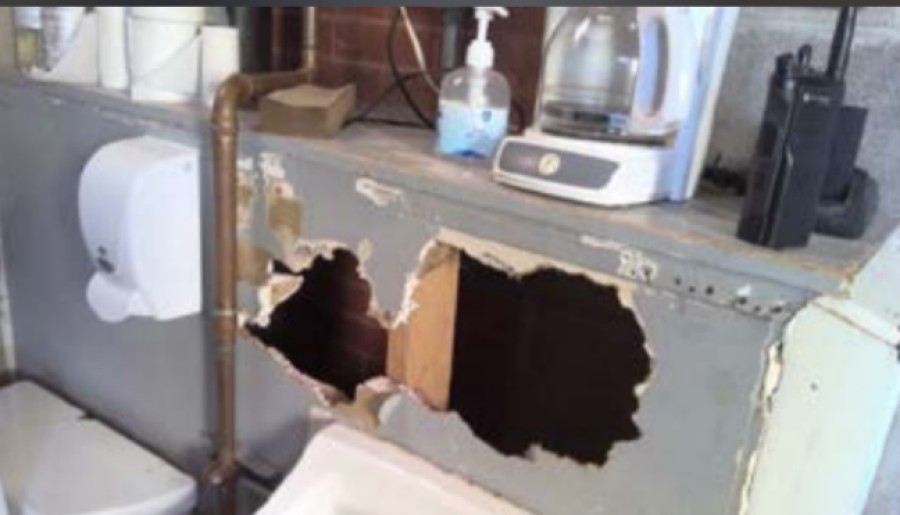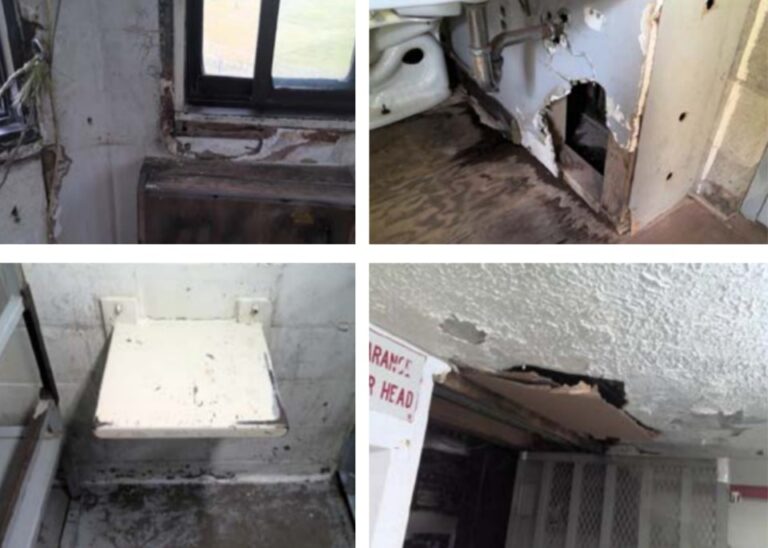If you ask Rhonda Thompson about the problems with Logan Correctional Center, the Illinois prison where she’s incarcerated, she can rattle off a long list. There’s the pollution from the 1930s coal plant that powers the prison. The brown, slimy water. The stubborn mold.
And of course, there’s the raccoons — she remembers seeing their tiny hands poking through holes in the walls.
“Our environment is toxic,” she said. “All of us have sinus, throat, breathing or lung and fatigue issues.”
Logan, one of two women’s facilities in the state, is not the only prison with major infrastructure issues. On a cold February night in 2022, a problem with heat and hot water forced Illinois officials to transfer dozens of men from Pontiac Correctional Center. That same month civil rights lawyers filed a lawsuit over black mold, vermin, and sewage back ups at the Stateville Northern Reception and Classification Center prison. And since last December, ten state prisons have had drinking water violation notices issued from the Illinois Environmental Protection Agency.
Stories of dire conditions in Illinois prisons have been trickling out for years, but a new report from a consulting company hired by the state of Illinois to assess its prison infrastructure shows the situation might be even worse than previously revealed. In the report, obtained by WBEZ, consultants rated three of the department’s 27 facilities as approaching “inoperable” and estimated the prison system has at least $2.5 billion of “deferred maintenance,” the highest of any state agency. That number is expected to double in five years if unaddressed.
The Illinois Department of Corrections declined a request for an interview. But, in a written statement, spokesperson Naomi Puzzello said the department has reviewed the report and “is in the beginning stages of internal discussions to determine the next steps necessary to meet the operational requirements of the agency.”
The report encourages major repairs and fixes. But in light of a dramatically decreased prison population over the last decade, it also recommends closing one prison and shrinking another. That’s a recommendation that is likely to be controversial — unions and communities surrounding prisons have historically fought to keep facilities from shrinking.
Despite differences over how the problem should be solved, state lawmakers from both sides of the aisle called for swift action after WBEZ showed them the state-commissioned consulting report.

State Sen. Terri Bryant, R-Murphysboro, who has multiple prisons in her district and spent 20 years working in the Department of Corrections, said some of the infrastructure issues, like extreme heat inside buildings or broken toilets, can make people agitated and increase tensions, maybe even leading to violence.
“At some point, someone’s going to get killed over the lack of attention to this deferred maintenance,” Bryant said.
A shrinking staff and an aging population
While the state-commissioned report focused on infrastructure issues, it also highlighted other problems that make the situation even more urgent — an elderly prison population and extreme short staffing, with around a quarter of positions vacant.
According to the report, the staffing crisis can be blamed in part on the remote, rural location of some prisons.
In September 2022, the executive director of the union for prison workers sent a letter to the head of the Department of Corrections warning that prisons were dangerously short staffed, according to documents obtained by WBEZ. She reported officers were “working to the point of exhaustion — 16 hours straight is all too common” and employees were suffering both mental and physical trauma, including some who had died by suicide.
Almost every aspect of the prison system is impacted by the extreme short staffing. There isn’t enough staff to transport people to outside healthcare appointments. Incarcerated people are left in their cells, unable to go to the dining hall for meals or outside for recreation because there is not enough security staff. One facility has about 40% of its guard positions unfilled.
Rafael Kennedy has been incarcerated since 2015 and said he waits weeks to see a mental health specialist, despite his serious needs.
“By the time guys are released this place has just thrown you in a cage and made some guys worse than what they were before,” Kennedy said.
While Illinois prison buildings have deteriorated and the staff has been shrinking, the needs of the people locked up in the prisons are only becoming greater.
People who were incarcerated in the “tough on crime” era of the ’80s and ’90s are starting to become elderly. About 32% of the IDOC population is now over 55 and the harsh conditions in prison mean people age faster, and so are more likely to be sick or disabled. That’s a big problem, considering most of the state’s prison facilities were built before the Americans with Disabilities Act, which requires buildings with proper accommodations.
In recent court filings over the state’s prison healthcare, an independent monitor noted that some showers on a prison healthcare unit weren’t accessible to people with disabilities. According to that report, one man used a wheelchair and had already had six falls. He “hadn’t showered in a long time and had an odor for which the roommate made homemade potpourri” and wheeled him down the hall, to clean in a sink.
Properly accommodating this aging and ailing population will require major repairs and updates. But civil rights lawyer Alan Mills, executive director at Uptown People’s Law Center, said that “before spending such huge sums, the state needs to carefully rethink who is in prison, and how long they need to be there.”
“Prisoners who are elderly, disabled, or terminally ill need to be released. Prisons should not ever be nursing homes,” Mills said. Advocates like Mills argue that not only is it inhumane and expensive to incarcerate this population — in many cases, they also pose little public safety risk, because of their age and incapacitation.
A call for closing prisons, and pushback
Even if the state does not make moves to release more elderly and sick people from prison, the Department of Corrections is still expected to have extra capacity, according to the report. Since 2012, there has been about a 40 percent drop in the number of people in Illinois prisons.
Jenny Vollen-Katz, executive director of the John Howard Association, a prison watchdog group, said all these factors — the shrinking prison population, staffing crisis, and decrepit buildings — are combining to create a key moment in the history of Illinois prisons.
“We have an opportunity to save a lot of money and be more responsive … to the humanity of the people who are incarcerated and frankly, the safety of the people that work inside our facilities,” Vollen-Katz said. “It is so clear from this report that many of these facilities are not needed and not safe.”
The report recommends closing Logan, which it called “unsuitable for any population,” and shrinking Pontiac, which has the second highest deferred maintenance costs of any prison in the state.
Anne Stava-Murray, D-Naperville, said it wasn’t smart for the state to keep patching holes, both metaphorically and literally, in a crumbling system.
“We as a state are better than this,” Stava-Murray said. “If we fail to live by our own moral and ethical standards in how we treat incarcerated people, how are we to expect that they will be motivated to reform themselves according to those same standards?”
But many people who work in prison and live in the communities nearby are skeptical of any efforts to shrink or close prisons.
Bryant, the state senator from southern Illinois, said there are people in her family who have worked in corrections going back for five generations. She calls corrections, the “family business.”
“At one time, corrections was the only place to get a good paying job in Southern Illinois,” Bryant said.
During the prison boom of the ’80s and ’90s, Illinois used prisons as a kind of jobs program for white rural towns. The state held “prison sweepstakes” and small towns competed against one another to “win” prisons and the jobs that came with them.

It’s difficult to assess the economic impacts of building prisons and studies suggest the benefits are limited. But residents and leaders in prison towns believe strongly in their importance to the local economy. Attempts to close prisons in the state over the last two decades have been met with fierce resistance both from local communities and the prison worker union AFSCME.
AFSCME officials declined to do an interview about the recent infrastructure report, but said they’ve long called for attention to infrastructure problems. Union officials said they would wait until they received the report directly from the Department of Corrections to say more.
Bryant said even if the extreme staffing shortages mean no one will be laid off if prisons close, it will mean the possibility for future jobs is curbed.
“When you reduce staffing, people move. When people move, your tax base comes down, right? So it’s all connected. It’s not … a one off, every single move that the Department of Corrections makes impacts the community that they’re in,” Bryant said.
Bryant conceded that prisons shouldn’t exist only to create jobs, but also argued she doesn’t think current downward incarceration trends are going to continue. “We’re not spending the money that we should for mental health, we’re not spending the money that we should to reduce recidivism. So they’re going to get locked up again, at some point. And at that point, we’ll be looking at billions of dollars to rebuild facilities.“
Vollen-Katz agreed that the state was not investing enough in mental health. She also agreed that the state needed to consider ways to support communities, like the ones in Bryant’s district, that might need economic support. But she said prisons are not the solution for either problem.
“What we’re talking about are people living surrounded by black mold, lack of ventilation. We’re talking about people that endure freezing temperatures in the winter and extreme heat in the summers without any relief,” she said. “I can’t imagine anybody thinking that that is a great use of resources to spend billions of dollars on old, decrepit, inhumane facilities.”
State Sen. Robert Peters, D-Chicago, acknowledged it was going to be a difficult debate in the state legislature considering the divergent views about prisons, but argued it was a moral necessity to address the awful conditions.
“What are we saying about who we are as a people and what we’re allowed to do to each other if we’re saying the state can do this to you?”
Shannon Heffernan is a criminal justice reporter for WBEZ. Follow her @shannon_h.

